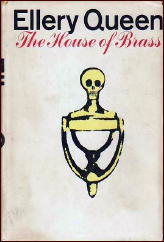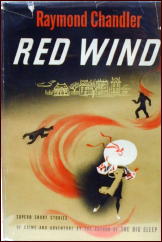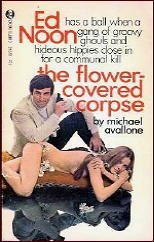Sun 1 Sep 2013
Mike Nevins on ELLERY QUEEN, RAYMOND CHANDLER and MICHAEL AVALLONE.
Posted by Steve under Authors , Columns , Pulp Fiction[14] Comments
by Francis M. Nevins
Hello again! I won’t attempt to describe the health problems that forced me to abandon this column and just about everything else these past few months, but they seem to be behind me now and I’m ready to take up where I left off. Care to join me?
Not long before I put the column on hiatus, I learned from Fred Dannay’s son Richard that I’d made a mistake in Ellery Queen: The Art of Detection, and I can’t think of a better place to correct it than here.
On page 241 of the book I state that the 1968 Queen novel The House of Brass was written by Avram Davidson from an outline by Fred. It’s true that Davidson was commissioned to and did expand Fred’s outline to book length, but that’s only a small part of the story, which is told in full in the Dannay papers, archived at Columbia University.

Among the House of Brass documents are: (1) two different drafts of Fred’s synopsis, one running 74 pages, the other 61; (2) Davidson’s expansion of the synopsis, which runs 181 pages; (3) two copies of the 266-page version of the novel written by Manny Lee after the Davidson version was rejected; (4) two copies of the final draft of the novel, which runs 275 typed pages. These facts are indisputable, and I thank Richard Dannay for sharing them with me.
As I documented in my February column, we know from Manny’s letter to Fred dated November 3, 1958 that he was at work turning a Dannay synopsis into a new novel but had been put behind schedule by health problems. (Whether these included the onset of writer’s block remains unknown.)
We also know that the book in question was not The Finishing Stroke, which had been published much earlier in 1958 and was the last novel in what I’ve called Queen’s third period. So what happened to the book Manny was working on near the end of the year?
I can envision three possibilities. (1) Fred gave up on it completely. (2) He gave up on it as a novel and he or another writer turned it into the novelet “The Death of Don Juan†(Argosy, May 1962; collected in Queens Full, 1965). (3) Manny went back to the project after recovering from writer’s block and it was published as Face to Face (1967).
My own guess, which is speculative but (I hope!) informed, is the third possibility. With that as my premise, I offer the following timeline.
1961 or 1962 — A decision is made to bring in other writers to perform Manny’s traditional function.
1963 — Publication of The Player on the Other Side, written by Theodore Sturgeon from Fred’s synopsis.
1964 — Publication of And on the Eighth Day, written by Avram Davidson from Fred’s synopsis.
1965 — Publication of The Fourth Side of the Triangle, written by Davidson from Fred’s synopsis.
1966? — Davidson expands Fred’s synopsis into The House of Brass, but Fred and Manny reject his version and the project is shelved.
1966 or 1967 — Manny recovers from writer’s block and finishes his work on the project that was left incomplete back in the late Fifties. This book is published as Face to Face (1967).
1967 or 1968 — Manny completely rewrites the rejected Davidson version of The House of Brass, which is published under that title in 1968.
The final Queen hardcover novels — Cop Out (1969), The Last Woman in His Life (1970), and A Fine and Private Place (1971), whose publication Manny did not live to see — were written by the cousins without input from outsiders, Fred preparing the plot synopses as usual and Manny expanding them to book length.
As editor of Ellery Queen’s Mystery Magazine, Fred had reprinted dozens of the pulp stories of Dashiell Hammett but just one tale by Raymond Chandler and that only after his death. Of course the vast majority of Chandler’s short fiction was too long for EQMM’s requirements, but from Fred’s point of view the most serious problem with the creator of Philip Marlowe was that, unlike Hammett, he had a pervasive tendency to get lost in his own plot labyrinths. In fact he once said that plot didn’t matter to him, only the individual scenes did.

This tendency can be seen as far back as his first published story, “Blackmailers Don’t Shoot†(Black Mask, December 1933; collected in Red Wind, World 1946, and in Stories and Early Novels, Library of America 1995).
Trying to make sense of this story is like trying to nail jelly to a wall. One of the main characters is Landrey, a gambler and racketeer who earlier in his life had tried to launch a Hollywood career. In those days he had had an affair with Rhonda Farr, a young beauty who had become a major star. Apparently wanting to rekindle the romance, Landrey pretends that Rhonda’s love letters to him had been stolen and has his underworld buddies demand blackmail money from her. Then he hires the story’s protagonist, a PI named Mallory, to thwart the blackmailers and recover the letters.
All these events have taken place before the story begins. Chandler opens with a nightclub scene where Mallory pretends to have the letters himself and, hoping to force the blackmailers to go after him, demands $5,000 from Rhonda. (What would he have done if she had said “Show me you have them�) Chandler never makes up his mind whether Rhonda had asked Landrey to help get her letters back.
At pages 71 and 106 of the Red Wind collection and pages 7 and 37 of the Library of America volume it seems she did, at pages 111 and 42 respectively it seems she didn’t. If she didn’t, how could Landrey have known she was being blackmailed unless he was behind it himself?
At no point does Chandler provide any details about how the letters were stolen. In fact at pages 104-105 and 36-37 respectively it’s hinted that Landrey had returned the letters long ago and that they’d been stolen not from him but from her. To make matters even more chaotic, he for no earthly reason is carrying the letters in his own pocket on the night of the action!
Simultaneously with the fake blackmail plot, Landrey has arranged for Rhonda to be kidnaped and held for ransom so that he can rescue her and earn her eternal gratitude. Apparently none of his underlings are ever privy to his overall plan, but a remark of Mallory’s — “When the decoy worked I knew it was fixed†(pp. 112 and 43 respectively) — suggests that in some mystic manner our sleuth knew the truth almost from the get-go.
Somehow, although again Chandler spares us any details, Landrey’s partner Mardonne is involved in the master scheme, and Mallory miraculously discovers this aspect of the plot too (pp. 115 and 46 respectively). Small wonder that Mardonne (on pp. 112 and 43 respectively) remarks “A bit loose in places.â€
Parsing other Chandler stories will have to be done by someone else. Life’s too short.
How better to celebrate one’s recovery from serious illness than with one of the immortal works of Michael Avallone? The Flower-Covered Corpse (1969) is rife with the scrambled sentences that are his unique claim to fame but I’ll limit myself to a handful. The “I†in these quotations is New York PI Ed Moon, who is to detectives what Ed Wood was to directors.

Blood played tag in my little grey cells.
“….Hep you may be but you are unitiate….â€
The mad evening had come to its final, inexorable totem pole of weird unreality.
More marbles scattered across the floor of what was left of my brain.
Right after War Two, he had plunged into the Police Academy bag and come up with an apple pie in each hand.
I didn’t have a client except myself and my own neck.
He tried to smile, still huddling his lovely fortune cookie.
Femininity and Melissa Mercer are blood sisters.
The .22 spit like a sneeze.
I said a handful and a hand has five fingers so I guess I should have stopped halfway through my list. But there’s something about Avalloneisms that almost forces me to say — again and again and again — “Just one more.†I hope you didn’t mind too much.
September 1st, 2013 at 4:28 pm
Good to read you again, I hope your health is nice enough to us to let you back on a regular schedule.
I much prefer Hammett over Chandler. I think THE BIG SLEEP is one of the best books ever written, but he repeats his characters and plots during his career too much.
Interesting to read a post examining Chandler and Avallone. Their writing are so similar.
September 1st, 2013 at 8:45 pm
Mike
I think your line “… in some mystic manner our sleuth knew the truth almost from the get-go.” sums up the detective work that goes on in this story quite satisfactorily.
Doesn’t matter much, though. Not in the slightest.
We have one vote for Hammett over Chandler so far, and one vote going the other way (mine). By the slightest of margins. You might ask me again tomorrow.
September 1st, 2013 at 10:17 pm
I like Hammett alot but I have to vote for Chandler over Hammett, so now it’s two to one in favor of Chandler.
September 1st, 2013 at 10:19 pm
Hammett always, but if the definition were to be extended just a bit, James Cain.
September 2nd, 2013 at 12:10 am
Put me in the Chandler camp. THE LONG GOODBYE is my all-time-favorite novel. The Avallone Ed Noon novels I read years ago, starting with THE BEDROOM BOLERO, fell into the so-bad-they’re-good category — just like Ed Wood’s films.
September 2nd, 2013 at 9:31 am
I prefer Hammett because his prose style is crisp whereas Chandler’s style is sometimes self-satisfied.
By the way I got today “Ellery Queen: The Art of Detection” and I am looking forward to read it.
September 2nd, 2013 at 9:42 am
Mike, I wonder why Dannay quibbled at Chandler’s sloppy plotting but put up with Woolrich, who always put mood over common sense.
As for ranking Chandler & Hammett, I don’t see the point in it; they each had their strengths & weaknesses, each is incredibly readable in his own way, and arguing over who was “better” is like trying to decide what was the greatest novel ever written or the best painting or the loveliest music.
Anyway, it’s good to have you back!
September 2nd, 2013 at 10:49 am
Good to have you back, Mike. Your new book on Ellery Queen is wonderful. I read only a few pages each day because I don’t want it to ever end! I’ll have to make a note when I get to your discussion of who wrote what on _The House of Brass_ so I know where this note may be found.
September 3rd, 2013 at 10:32 am
First off, welcome back from the sickbed.
I was wondering what happened to you; I was a little scared that you’d seen the comment I sent in about Author, Author last time and gotten lost in the search …
Anyhow, now that I brought it up, is there a there there?
So everybody won’t have to scroll back, this is what I’m referring to:
In my TV Guide for February 13-19, 1960, there’s a squib in the TV Teletype, thus:
ABC’s mulling a new series about books, Author, Author for next season. Writers CLIFTON FADIMAN, MARC CONNELLY, S.J. PERELMAN, RONA JAFFE, and MANFRED LEE took part in the audition tape …
I re-emphasized that last part, which indicates that a tape was made.
I know that the odds of such a tape still existing are miniscule at best, but maybe there might be a written record of this pilot being produced, perhaps even a transcript of the show itself … something, anything … whatever.
I’m all too aware of what a pest I can get to be about things like this, and I apologize for that.
But ever since I found that Teletype item, I can’t shake loose of it.
Maybe in the archives somewhere there’s a loose memo or something to confirm that an Author, Author pilot did get made.
I’d like to see even that.
The EQ book is great, as expected, but I was sorry to see that you apparently still buy into that business about the Lawford/EQ having been earmarked for the NBC Mystery Movie, only to be replaced by McMillan & Wife; that story has been discredited in several places, notably at The Rap Sheet in an interview with Paul Mason, a Universal TV exec who was in a better position to know than most.
I’m nitpicking here (see pest, above); the book is invaluable as it stands, and I’m glad that you put it together for all of us.
Stay well … please?
September 3rd, 2013 at 11:46 am
As I read your cogent comments on the EQ radio shows I am struck by how many lack something necessary for a Queen story, mostly logic. My favorite is the story about the arsenic-laced stew that didn’t kill everyone who ate it. I’m glad to see the script has been preserved and in the fullness of time I will have to read that. Only a handful of the audio versions of the show survive and after reading that chapter I wonder if perhaps it is just as well.
September 5th, 2013 at 9:33 am
Welcome back, Mike! On the Hammett vs. Chandler question, I’d settle for a dead heat. But does anybody share Anthony Boucher’s opinion (which I lead toward agreeing with) that Ross Macdonald was a better novelist than either, albeit less of an innovator?
September 5th, 2013 at 11:39 am
11. Jon, every writer has his or her own style and some styles appeal to each reader more than others. It has been awhile since I have re-read Ross Macdonald but remember him as boring.
I find Hammett more real with his cynical witty look on life than the fairy tale class struggle of Chandler’s Marlowe. Macdonald’s Archer lacked humor or wit (as I remember) and never entertained me the way Hammett did. But there are mystery writers I enjoy reading more than all three.
Hammett opened my eyes to the fact that mystery fiction could be more than a pointless game. It could be about people and life. Hammett’s work and characters have more range than Chandler’s Marlowe and short stories characters and R. Macdonald’s Archer.
September 11th, 2013 at 9:03 am
I think Anthony Boucher and Jon L. Breen have a point about Ross Macdonald. I read all his Lew Archer novels back in the 1960’s and 1970’s and enjoyed them. A couple years ago, I thought I’d try to reread a couple and I ended up rereading all 18 in the Archer series.
I then reread Chandler and Hammett and enjoyed them also. As far as I’m concerned the Big Three of hard boiled fiction is made up of Chandler, Hammett, and Macdonald.
Then the next level would be James Cain, Paul Cain, John D. Macdonald, etc. Followed by other writers like Fred Nebel, Norbert Davis, Merle Constiner.
September 11th, 2013 at 2:28 pm
13. Thanks Walker, I thought I had scared everyone off.
Its hard to rank anything when our tastes and perspective changes. I need humor or wit in my mysteries so it is no surprise that of those you mentioned Hammett and Norbert Davis are the only ones on my list. I need to read more of Paul Cain and Merle Constiner to form a realistic opinion about them.
Gregory Mcdonald and Craig Rice join Norbert Davis on my list of major influences to my favorite type of mystery, mystery lite (comedy mystery where the mystery is featured over the comedy).
I am still forming an opinion on Henry Kane, and find Paul Ernst hit or miss (THE AVENGER is how I got interested in pulps after I had tried and rejected TARZAN, THE SHADOW, DOC SAVAGE, etc).
The writers I enjoy most had (have) little influence on the genre, writers such as Ross Thomas, Jasper Fforde, Paco Ignacio Taibo II, and Vince Kohler. So who is the greatest doesn’t matter much to me.